Tesco: Leadership, Management, and Operational Approaches Report
VerifiedAdded on 2023/01/06
|13
|3798
|42
Report
AI Summary
This report provides a comprehensive analysis of leadership and management within Tesco, a multinational retail organization. It defines and compares the roles and characteristics of leaders and managers, examining their application in various situational contexts. The report explores different leadership theories and models, including situational, systems, and contingency leadership, and their relevance to Tesco's operations. It also explains key approaches to operations management, emphasizing the roles of leaders and managers in achieving business objectives. Furthermore, the report assesses factors within the business environment impacting operational management and decision-making. The content includes roles of leader and manager, team building, situational and contingency leadership theories and operational approaches, and the importance of operations management in achieving business objectives.
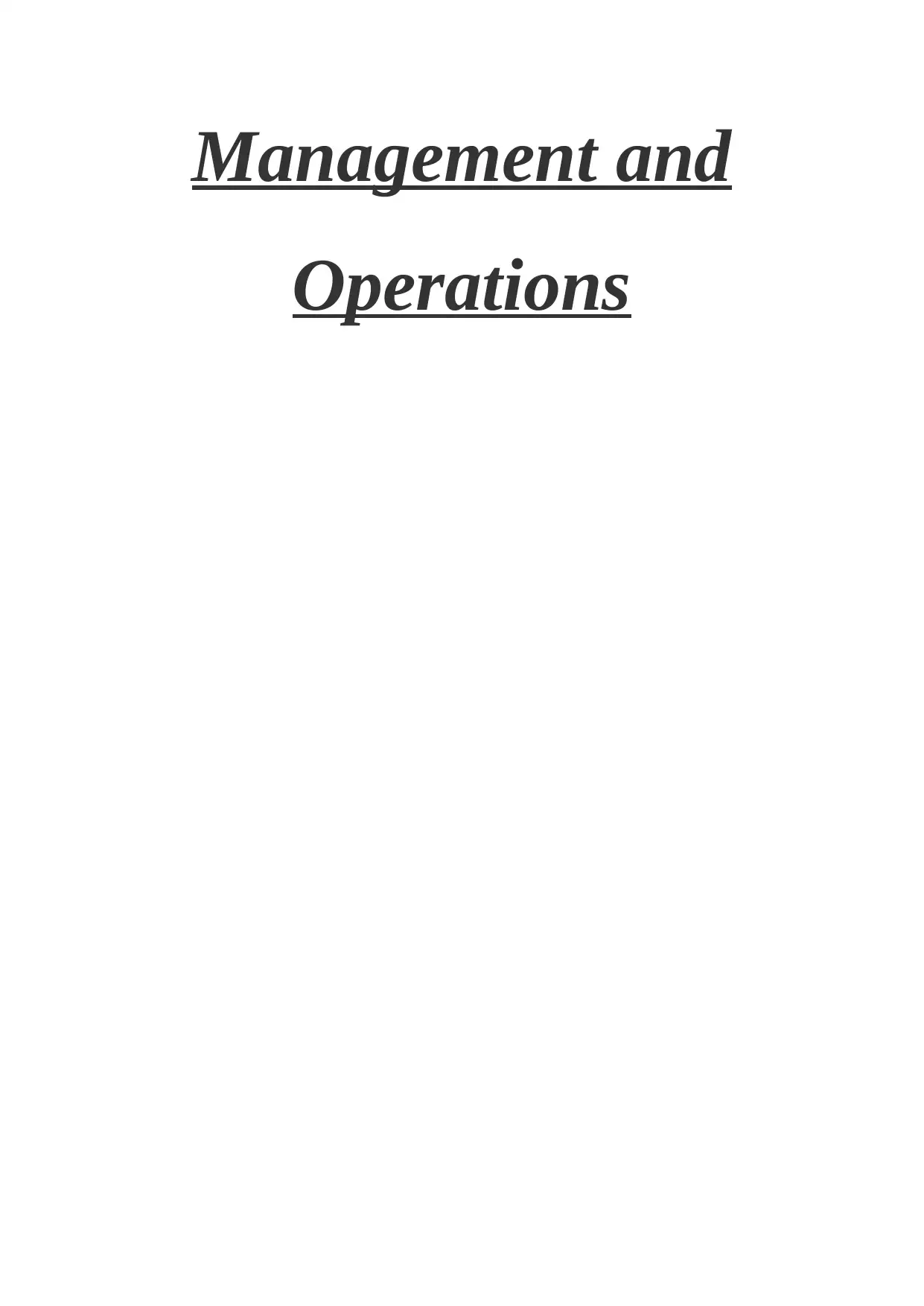
Management and
Operations
Operations
Paraphrase This Document
Need a fresh take? Get an instant paraphrase of this document with our AI Paraphraser
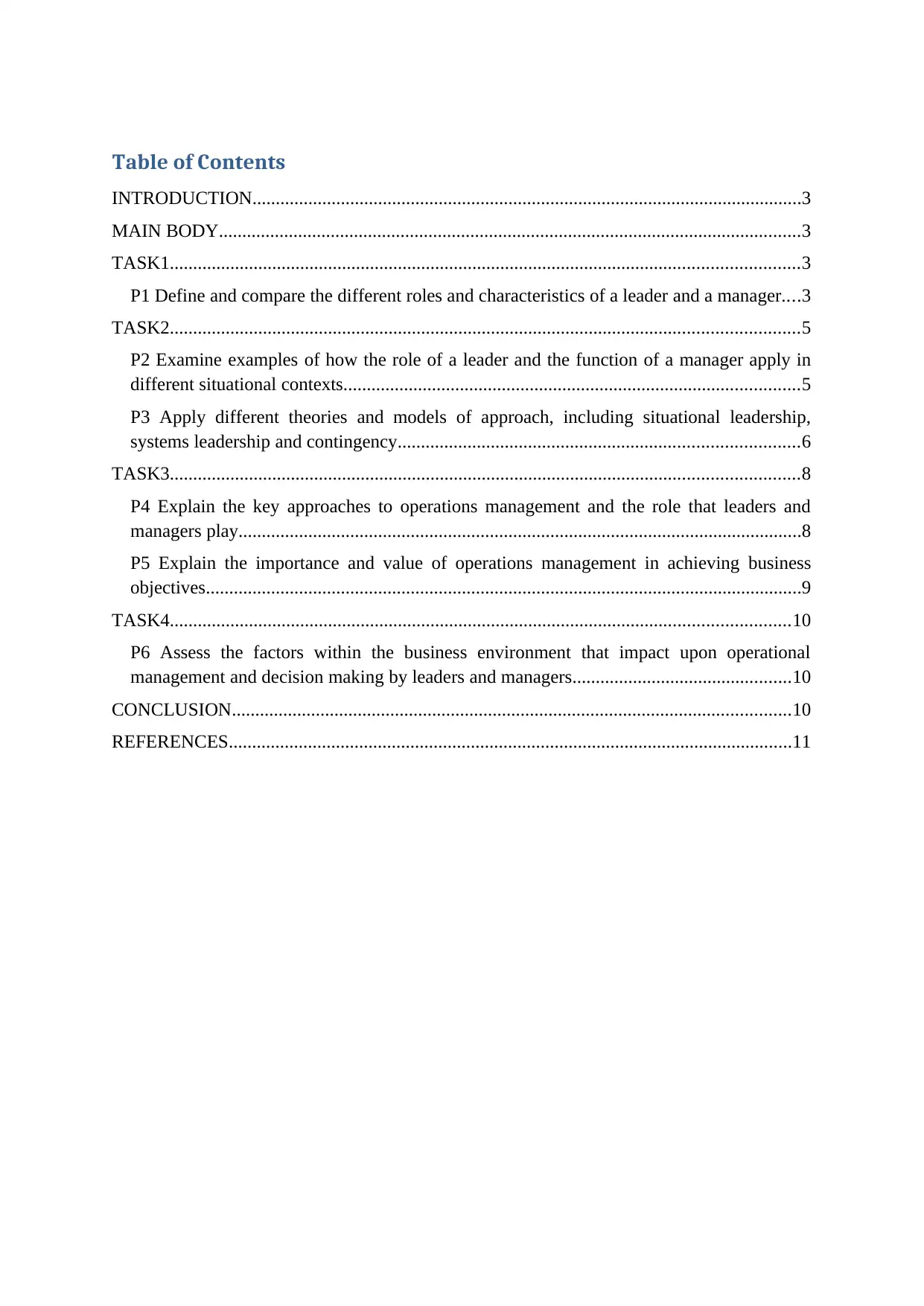
Table of Contents
INTRODUCTION......................................................................................................................3
MAIN BODY.............................................................................................................................3
TASK1.......................................................................................................................................3
P1 Define and compare the different roles and characteristics of a leader and a manager....3
TASK2.......................................................................................................................................5
P2 Examine examples of how the role of a leader and the function of a manager apply in
different situational contexts..................................................................................................5
P3 Apply different theories and models of approach, including situational leadership,
systems leadership and contingency......................................................................................6
TASK3.......................................................................................................................................8
P4 Explain the key approaches to operations management and the role that leaders and
managers play.........................................................................................................................8
P5 Explain the importance and value of operations management in achieving business
objectives................................................................................................................................9
TASK4.....................................................................................................................................10
P6 Assess the factors within the business environment that impact upon operational
management and decision making by leaders and managers...............................................10
CONCLUSION........................................................................................................................10
REFERENCES.........................................................................................................................11
INTRODUCTION......................................................................................................................3
MAIN BODY.............................................................................................................................3
TASK1.......................................................................................................................................3
P1 Define and compare the different roles and characteristics of a leader and a manager....3
TASK2.......................................................................................................................................5
P2 Examine examples of how the role of a leader and the function of a manager apply in
different situational contexts..................................................................................................5
P3 Apply different theories and models of approach, including situational leadership,
systems leadership and contingency......................................................................................6
TASK3.......................................................................................................................................8
P4 Explain the key approaches to operations management and the role that leaders and
managers play.........................................................................................................................8
P5 Explain the importance and value of operations management in achieving business
objectives................................................................................................................................9
TASK4.....................................................................................................................................10
P6 Assess the factors within the business environment that impact upon operational
management and decision making by leaders and managers...............................................10
CONCLUSION........................................................................................................................10
REFERENCES.........................................................................................................................11
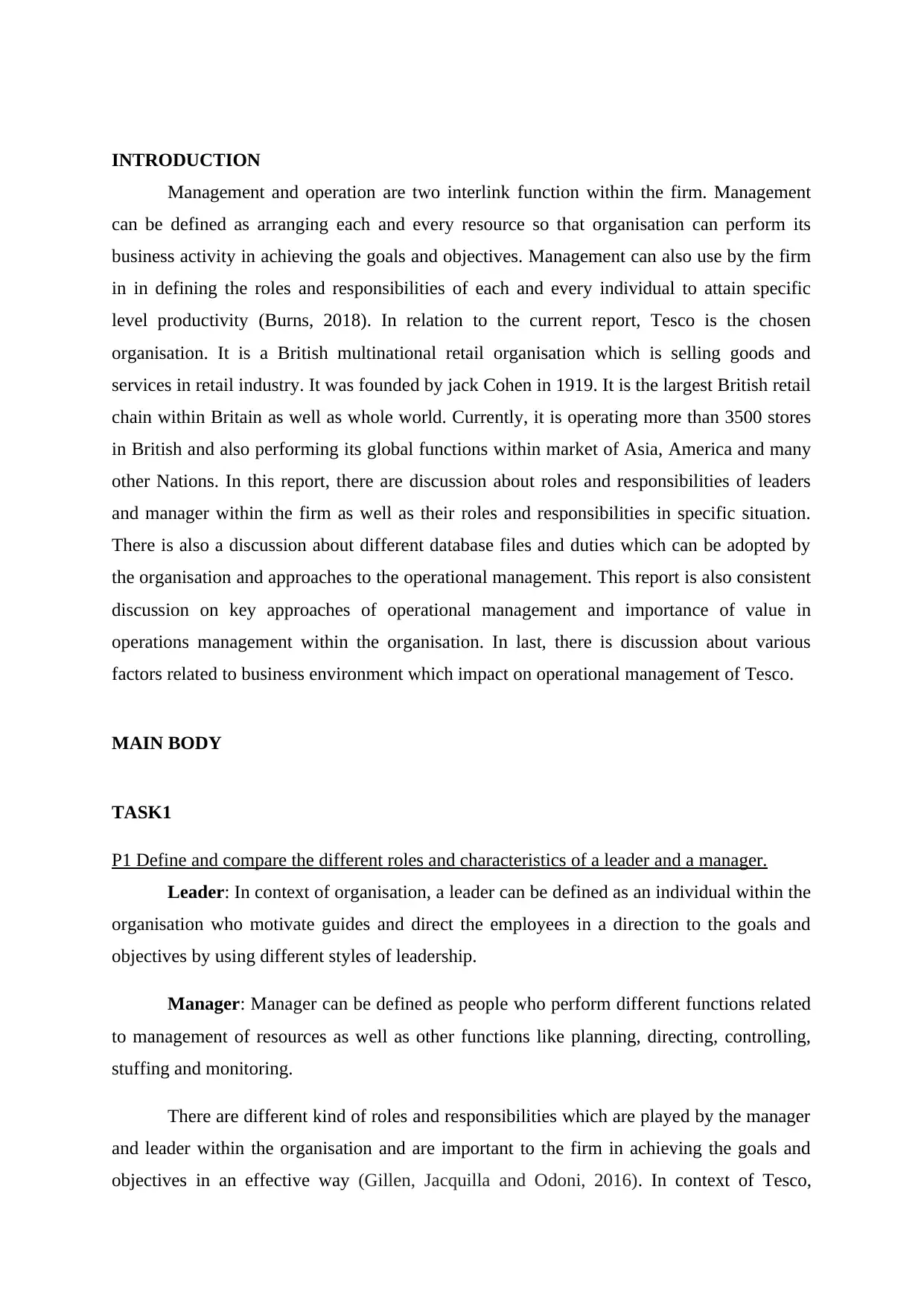
INTRODUCTION
Management and operation are two interlink function within the firm. Management
can be defined as arranging each and every resource so that organisation can perform its
business activity in achieving the goals and objectives. Management can also use by the firm
in in defining the roles and responsibilities of each and every individual to attain specific
level productivity (Burns, 2018). In relation to the current report, Tesco is the chosen
organisation. It is a British multinational retail organisation which is selling goods and
services in retail industry. It was founded by jack Cohen in 1919. It is the largest British retail
chain within Britain as well as whole world. Currently, it is operating more than 3500 stores
in British and also performing its global functions within market of Asia, America and many
other Nations. In this report, there are discussion about roles and responsibilities of leaders
and manager within the firm as well as their roles and responsibilities in specific situation.
There is also a discussion about different database files and duties which can be adopted by
the organisation and approaches to the operational management. This report is also consistent
discussion on key approaches of operational management and importance of value in
operations management within the organisation. In last, there is discussion about various
factors related to business environment which impact on operational management of Tesco.
MAIN BODY
TASK1
P1 Define and compare the different roles and characteristics of a leader and a manager.
Leader: In context of organisation, a leader can be defined as an individual within the
organisation who motivate guides and direct the employees in a direction to the goals and
objectives by using different styles of leadership.
Manager: Manager can be defined as people who perform different functions related
to management of resources as well as other functions like planning, directing, controlling,
stuffing and monitoring.
There are different kind of roles and responsibilities which are played by the manager
and leader within the organisation and are important to the firm in achieving the goals and
objectives in an effective way (Gillen, Jacquilla and Odoni, 2016). In context of Tesco,
Management and operation are two interlink function within the firm. Management
can be defined as arranging each and every resource so that organisation can perform its
business activity in achieving the goals and objectives. Management can also use by the firm
in in defining the roles and responsibilities of each and every individual to attain specific
level productivity (Burns, 2018). In relation to the current report, Tesco is the chosen
organisation. It is a British multinational retail organisation which is selling goods and
services in retail industry. It was founded by jack Cohen in 1919. It is the largest British retail
chain within Britain as well as whole world. Currently, it is operating more than 3500 stores
in British and also performing its global functions within market of Asia, America and many
other Nations. In this report, there are discussion about roles and responsibilities of leaders
and manager within the firm as well as their roles and responsibilities in specific situation.
There is also a discussion about different database files and duties which can be adopted by
the organisation and approaches to the operational management. This report is also consistent
discussion on key approaches of operational management and importance of value in
operations management within the organisation. In last, there is discussion about various
factors related to business environment which impact on operational management of Tesco.
MAIN BODY
TASK1
P1 Define and compare the different roles and characteristics of a leader and a manager.
Leader: In context of organisation, a leader can be defined as an individual within the
organisation who motivate guides and direct the employees in a direction to the goals and
objectives by using different styles of leadership.
Manager: Manager can be defined as people who perform different functions related
to management of resources as well as other functions like planning, directing, controlling,
stuffing and monitoring.
There are different kind of roles and responsibilities which are played by the manager
and leader within the organisation and are important to the firm in achieving the goals and
objectives in an effective way (Gillen, Jacquilla and Odoni, 2016). In context of Tesco,
⊘ This is a preview!⊘
Do you want full access?
Subscribe today to unlock all pages.

Trusted by 1+ million students worldwide
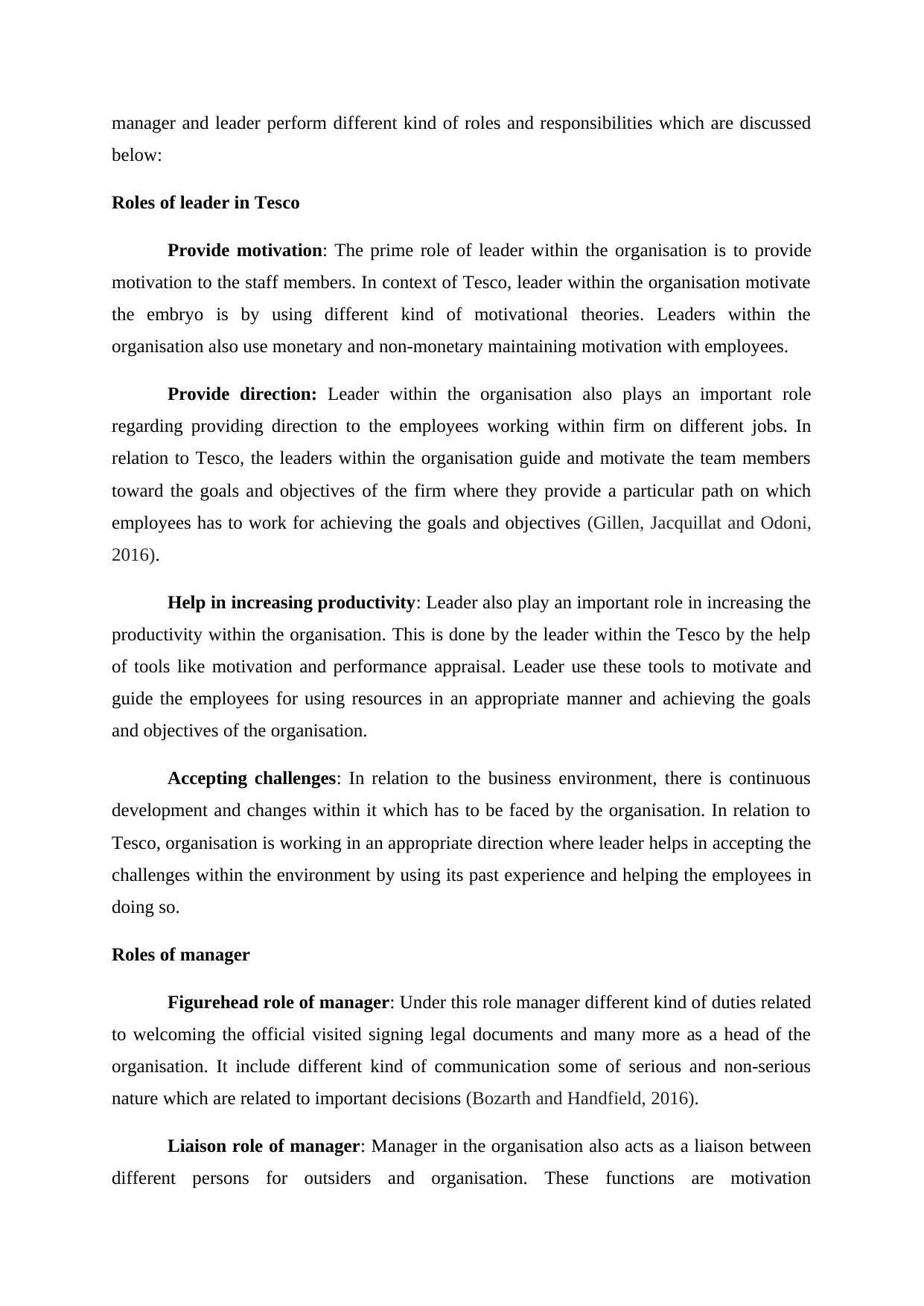
manager and leader perform different kind of roles and responsibilities which are discussed
below:
Roles of leader in Tesco
Provide motivation: The prime role of leader within the organisation is to provide
motivation to the staff members. In context of Tesco, leader within the organisation motivate
the embryo is by using different kind of motivational theories. Leaders within the
organisation also use monetary and non-monetary maintaining motivation with employees.
Provide direction: Leader within the organisation also plays an important role
regarding providing direction to the employees working within firm on different jobs. In
relation to Tesco, the leaders within the organisation guide and motivate the team members
toward the goals and objectives of the firm where they provide a particular path on which
employees has to work for achieving the goals and objectives (Gillen, Jacquillat and Odoni,
2016).
Help in increasing productivity: Leader also play an important role in increasing the
productivity within the organisation. This is done by the leader within the Tesco by the help
of tools like motivation and performance appraisal. Leader use these tools to motivate and
guide the employees for using resources in an appropriate manner and achieving the goals
and objectives of the organisation.
Accepting challenges: In relation to the business environment, there is continuous
development and changes within it which has to be faced by the organisation. In relation to
Tesco, organisation is working in an appropriate direction where leader helps in accepting the
challenges within the environment by using its past experience and helping the employees in
doing so.
Roles of manager
Figurehead role of manager: Under this role manager different kind of duties related
to welcoming the official visited signing legal documents and many more as a head of the
organisation. It include different kind of communication some of serious and non-serious
nature which are related to important decisions (Bozarth and Handfield, 2016).
Liaison role of manager: Manager in the organisation also acts as a liaison between
different persons for outsiders and organisation. These functions are motivation
below:
Roles of leader in Tesco
Provide motivation: The prime role of leader within the organisation is to provide
motivation to the staff members. In context of Tesco, leader within the organisation motivate
the embryo is by using different kind of motivational theories. Leaders within the
organisation also use monetary and non-monetary maintaining motivation with employees.
Provide direction: Leader within the organisation also plays an important role
regarding providing direction to the employees working within firm on different jobs. In
relation to Tesco, the leaders within the organisation guide and motivate the team members
toward the goals and objectives of the firm where they provide a particular path on which
employees has to work for achieving the goals and objectives (Gillen, Jacquillat and Odoni,
2016).
Help in increasing productivity: Leader also play an important role in increasing the
productivity within the organisation. This is done by the leader within the Tesco by the help
of tools like motivation and performance appraisal. Leader use these tools to motivate and
guide the employees for using resources in an appropriate manner and achieving the goals
and objectives of the organisation.
Accepting challenges: In relation to the business environment, there is continuous
development and changes within it which has to be faced by the organisation. In relation to
Tesco, organisation is working in an appropriate direction where leader helps in accepting the
challenges within the environment by using its past experience and helping the employees in
doing so.
Roles of manager
Figurehead role of manager: Under this role manager different kind of duties related
to welcoming the official visited signing legal documents and many more as a head of the
organisation. It include different kind of communication some of serious and non-serious
nature which are related to important decisions (Bozarth and Handfield, 2016).
Liaison role of manager: Manager in the organisation also acts as a liaison between
different persons for outsiders and organisation. These functions are motivation
Paraphrase This Document
Need a fresh take? Get an instant paraphrase of this document with our AI Paraphraser
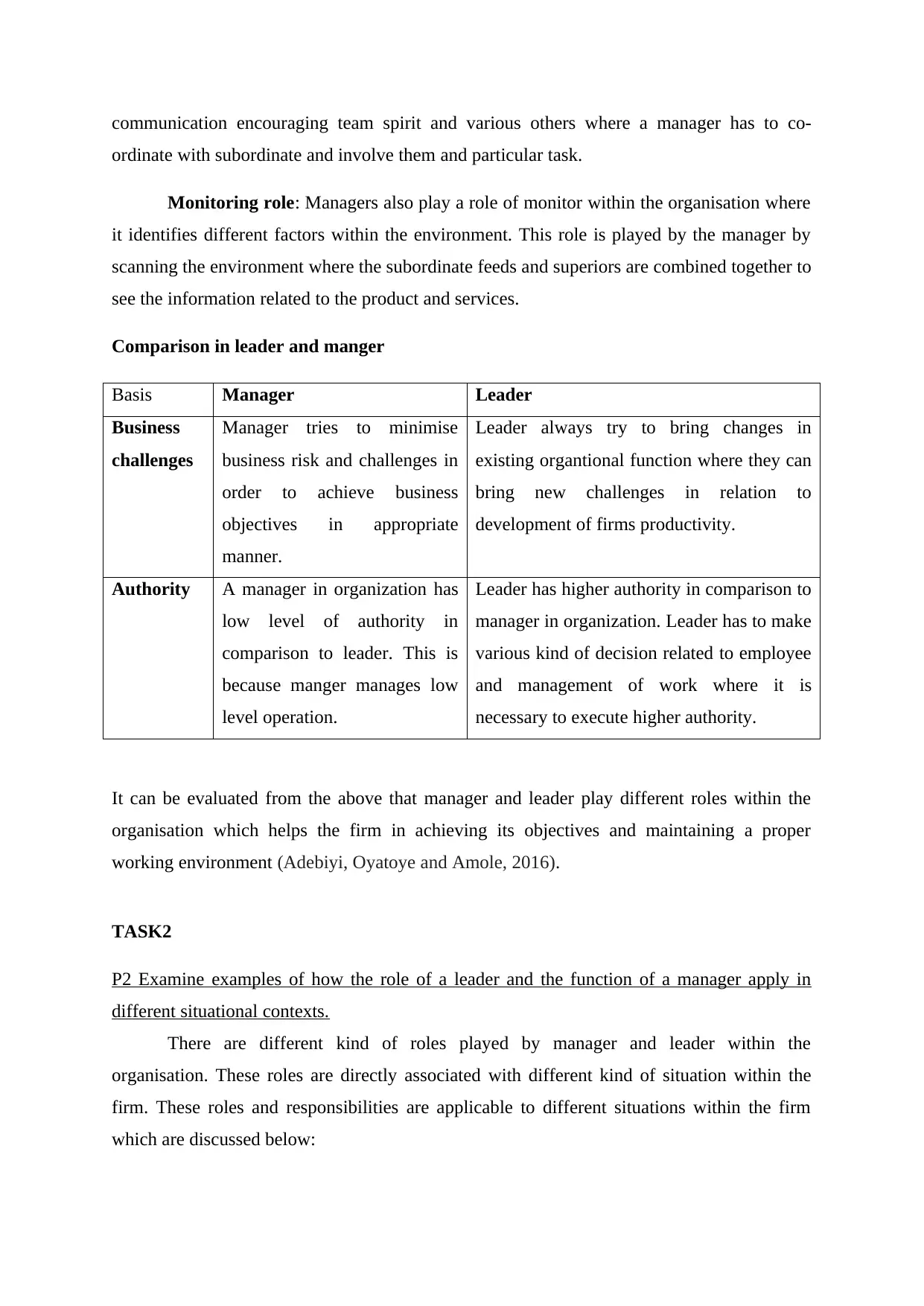
communication encouraging team spirit and various others where a manager has to co-
ordinate with subordinate and involve them and particular task.
Monitoring role: Managers also play a role of monitor within the organisation where
it identifies different factors within the environment. This role is played by the manager by
scanning the environment where the subordinate feeds and superiors are combined together to
see the information related to the product and services.
Comparison in leader and manger
Basis Manager Leader
Business
challenges
Manager tries to minimise
business risk and challenges in
order to achieve business
objectives in appropriate
manner.
Leader always try to bring changes in
existing organtional function where they can
bring new challenges in relation to
development of firms productivity.
Authority A manager in organization has
low level of authority in
comparison to leader. This is
because manger manages low
level operation.
Leader has higher authority in comparison to
manager in organization. Leader has to make
various kind of decision related to employee
and management of work where it is
necessary to execute higher authority.
It can be evaluated from the above that manager and leader play different roles within the
organisation which helps the firm in achieving its objectives and maintaining a proper
working environment (Adebiyi, Oyatoye and Amole, 2016).
TASK2
P2 Examine examples of how the role of a leader and the function of a manager apply in
different situational contexts.
There are different kind of roles played by manager and leader within the
organisation. These roles are directly associated with different kind of situation within the
firm. These roles and responsibilities are applicable to different situations within the firm
which are discussed below:
ordinate with subordinate and involve them and particular task.
Monitoring role: Managers also play a role of monitor within the organisation where
it identifies different factors within the environment. This role is played by the manager by
scanning the environment where the subordinate feeds and superiors are combined together to
see the information related to the product and services.
Comparison in leader and manger
Basis Manager Leader
Business
challenges
Manager tries to minimise
business risk and challenges in
order to achieve business
objectives in appropriate
manner.
Leader always try to bring changes in
existing organtional function where they can
bring new challenges in relation to
development of firms productivity.
Authority A manager in organization has
low level of authority in
comparison to leader. This is
because manger manages low
level operation.
Leader has higher authority in comparison to
manager in organization. Leader has to make
various kind of decision related to employee
and management of work where it is
necessary to execute higher authority.
It can be evaluated from the above that manager and leader play different roles within the
organisation which helps the firm in achieving its objectives and maintaining a proper
working environment (Adebiyi, Oyatoye and Amole, 2016).
TASK2
P2 Examine examples of how the role of a leader and the function of a manager apply in
different situational contexts.
There are different kind of roles played by manager and leader within the
organisation. These roles are directly associated with different kind of situation within the
firm. These roles and responsibilities are applicable to different situations within the firm
which are discussed below:
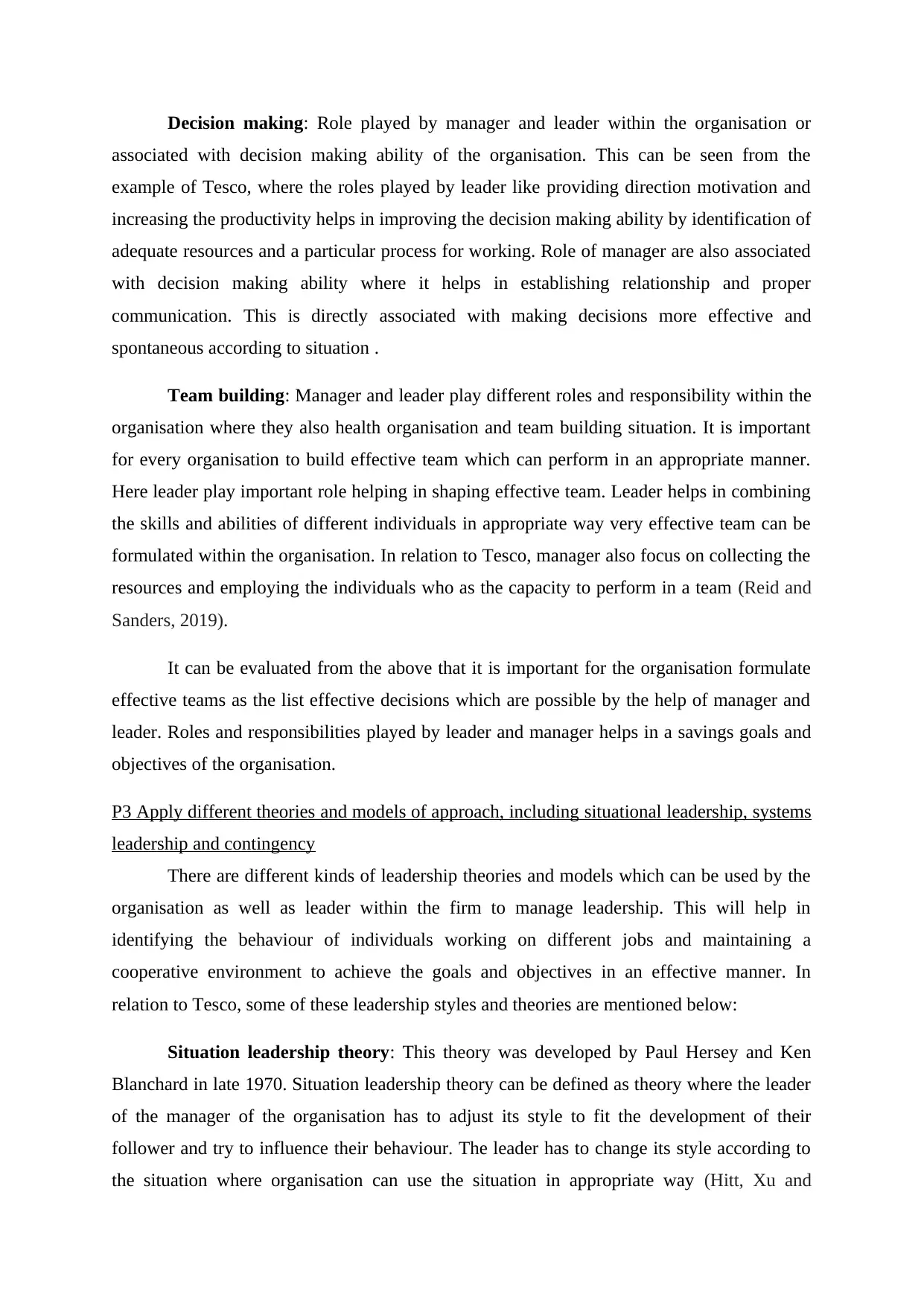
Decision making: Role played by manager and leader within the organisation or
associated with decision making ability of the organisation. This can be seen from the
example of Tesco, where the roles played by leader like providing direction motivation and
increasing the productivity helps in improving the decision making ability by identification of
adequate resources and a particular process for working. Role of manager are also associated
with decision making ability where it helps in establishing relationship and proper
communication. This is directly associated with making decisions more effective and
spontaneous according to situation .
Team building: Manager and leader play different roles and responsibility within the
organisation where they also health organisation and team building situation. It is important
for every organisation to build effective team which can perform in an appropriate manner.
Here leader play important role helping in shaping effective team. Leader helps in combining
the skills and abilities of different individuals in appropriate way very effective team can be
formulated within the organisation. In relation to Tesco, manager also focus on collecting the
resources and employing the individuals who as the capacity to perform in a team (Reid and
Sanders, 2019).
It can be evaluated from the above that it is important for the organisation formulate
effective teams as the list effective decisions which are possible by the help of manager and
leader. Roles and responsibilities played by leader and manager helps in a savings goals and
objectives of the organisation.
P3 Apply different theories and models of approach, including situational leadership, systems
leadership and contingency
There are different kinds of leadership theories and models which can be used by the
organisation as well as leader within the firm to manage leadership. This will help in
identifying the behaviour of individuals working on different jobs and maintaining a
cooperative environment to achieve the goals and objectives in an effective manner. In
relation to Tesco, some of these leadership styles and theories are mentioned below:
Situation leadership theory: This theory was developed by Paul Hersey and Ken
Blanchard in late 1970. Situation leadership theory can be defined as theory where the leader
of the manager of the organisation has to adjust its style to fit the development of their
follower and try to influence their behaviour. The leader has to change its style according to
the situation where organisation can use the situation in appropriate way (Hitt, Xu and
associated with decision making ability of the organisation. This can be seen from the
example of Tesco, where the roles played by leader like providing direction motivation and
increasing the productivity helps in improving the decision making ability by identification of
adequate resources and a particular process for working. Role of manager are also associated
with decision making ability where it helps in establishing relationship and proper
communication. This is directly associated with making decisions more effective and
spontaneous according to situation .
Team building: Manager and leader play different roles and responsibility within the
organisation where they also health organisation and team building situation. It is important
for every organisation to build effective team which can perform in an appropriate manner.
Here leader play important role helping in shaping effective team. Leader helps in combining
the skills and abilities of different individuals in appropriate way very effective team can be
formulated within the organisation. In relation to Tesco, manager also focus on collecting the
resources and employing the individuals who as the capacity to perform in a team (Reid and
Sanders, 2019).
It can be evaluated from the above that it is important for the organisation formulate
effective teams as the list effective decisions which are possible by the help of manager and
leader. Roles and responsibilities played by leader and manager helps in a savings goals and
objectives of the organisation.
P3 Apply different theories and models of approach, including situational leadership, systems
leadership and contingency
There are different kinds of leadership theories and models which can be used by the
organisation as well as leader within the firm to manage leadership. This will help in
identifying the behaviour of individuals working on different jobs and maintaining a
cooperative environment to achieve the goals and objectives in an effective manner. In
relation to Tesco, some of these leadership styles and theories are mentioned below:
Situation leadership theory: This theory was developed by Paul Hersey and Ken
Blanchard in late 1970. Situation leadership theory can be defined as theory where the leader
of the manager of the organisation has to adjust its style to fit the development of their
follower and try to influence their behaviour. The leader has to change its style according to
the situation where organisation can use the situation in appropriate way (Hitt, Xu and
⊘ This is a preview!⊘
Do you want full access?
Subscribe today to unlock all pages.

Trusted by 1+ million students worldwide
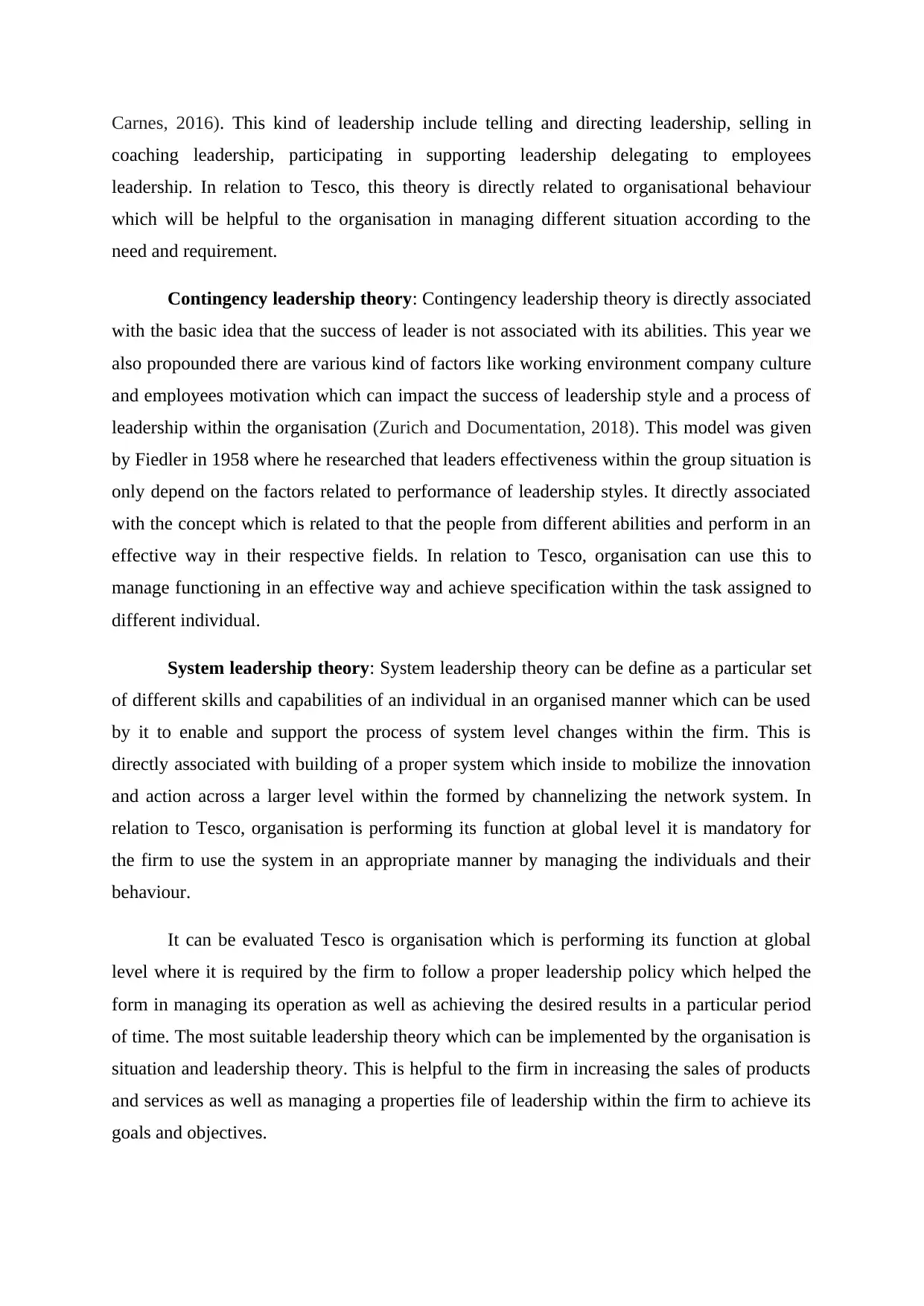
Carnes, 2016). This kind of leadership include telling and directing leadership, selling in
coaching leadership, participating in supporting leadership delegating to employees
leadership. In relation to Tesco, this theory is directly related to organisational behaviour
which will be helpful to the organisation in managing different situation according to the
need and requirement.
Contingency leadership theory: Contingency leadership theory is directly associated
with the basic idea that the success of leader is not associated with its abilities. This year we
also propounded there are various kind of factors like working environment company culture
and employees motivation which can impact the success of leadership style and a process of
leadership within the organisation (Zurich and Documentation, 2018). This model was given
by Fiedler in 1958 where he researched that leaders effectiveness within the group situation is
only depend on the factors related to performance of leadership styles. It directly associated
with the concept which is related to that the people from different abilities and perform in an
effective way in their respective fields. In relation to Tesco, organisation can use this to
manage functioning in an effective way and achieve specification within the task assigned to
different individual.
System leadership theory: System leadership theory can be define as a particular set
of different skills and capabilities of an individual in an organised manner which can be used
by it to enable and support the process of system level changes within the firm. This is
directly associated with building of a proper system which inside to mobilize the innovation
and action across a larger level within the formed by channelizing the network system. In
relation to Tesco, organisation is performing its function at global level it is mandatory for
the firm to use the system in an appropriate manner by managing the individuals and their
behaviour.
It can be evaluated Tesco is organisation which is performing its function at global
level where it is required by the firm to follow a proper leadership policy which helped the
form in managing its operation as well as achieving the desired results in a particular period
of time. The most suitable leadership theory which can be implemented by the organisation is
situation and leadership theory. This is helpful to the firm in increasing the sales of products
and services as well as managing a properties file of leadership within the firm to achieve its
goals and objectives.
coaching leadership, participating in supporting leadership delegating to employees
leadership. In relation to Tesco, this theory is directly related to organisational behaviour
which will be helpful to the organisation in managing different situation according to the
need and requirement.
Contingency leadership theory: Contingency leadership theory is directly associated
with the basic idea that the success of leader is not associated with its abilities. This year we
also propounded there are various kind of factors like working environment company culture
and employees motivation which can impact the success of leadership style and a process of
leadership within the organisation (Zurich and Documentation, 2018). This model was given
by Fiedler in 1958 where he researched that leaders effectiveness within the group situation is
only depend on the factors related to performance of leadership styles. It directly associated
with the concept which is related to that the people from different abilities and perform in an
effective way in their respective fields. In relation to Tesco, organisation can use this to
manage functioning in an effective way and achieve specification within the task assigned to
different individual.
System leadership theory: System leadership theory can be define as a particular set
of different skills and capabilities of an individual in an organised manner which can be used
by it to enable and support the process of system level changes within the firm. This is
directly associated with building of a proper system which inside to mobilize the innovation
and action across a larger level within the formed by channelizing the network system. In
relation to Tesco, organisation is performing its function at global level it is mandatory for
the firm to use the system in an appropriate manner by managing the individuals and their
behaviour.
It can be evaluated Tesco is organisation which is performing its function at global
level where it is required by the firm to follow a proper leadership policy which helped the
form in managing its operation as well as achieving the desired results in a particular period
of time. The most suitable leadership theory which can be implemented by the organisation is
situation and leadership theory. This is helpful to the firm in increasing the sales of products
and services as well as managing a properties file of leadership within the firm to achieve its
goals and objectives.
Paraphrase This Document
Need a fresh take? Get an instant paraphrase of this document with our AI Paraphraser
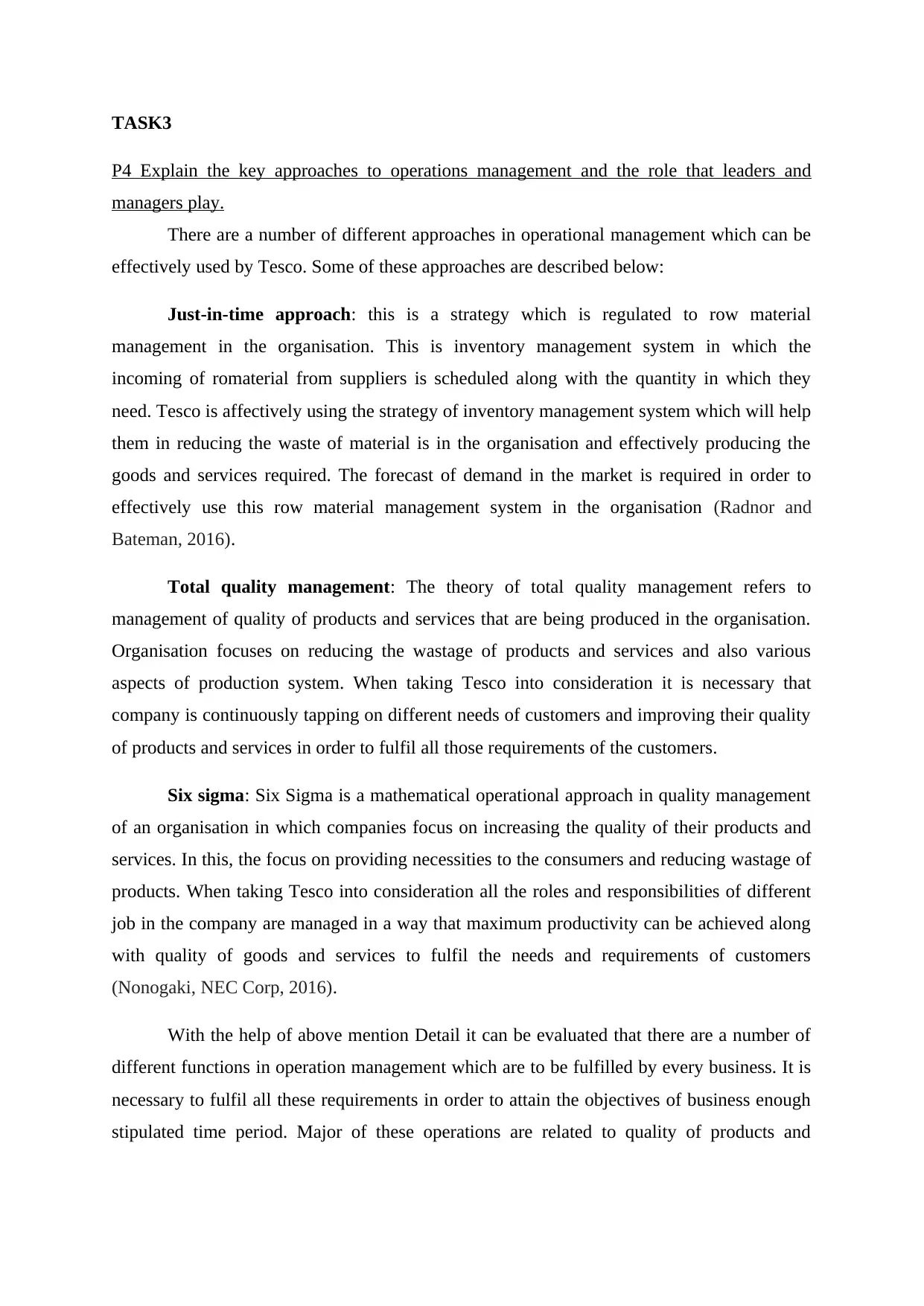
TASK3
P4 Explain the key approaches to operations management and the role that leaders and
managers play.
There are a number of different approaches in operational management which can be
effectively used by Tesco. Some of these approaches are described below:
Just-in-time approach: this is a strategy which is regulated to row material
management in the organisation. This is inventory management system in which the
incoming of romaterial from suppliers is scheduled along with the quantity in which they
need. Tesco is affectively using the strategy of inventory management system which will help
them in reducing the waste of material is in the organisation and effectively producing the
goods and services required. The forecast of demand in the market is required in order to
effectively use this row material management system in the organisation (Radnor and
Bateman, 2016).
Total quality management: The theory of total quality management refers to
management of quality of products and services that are being produced in the organisation.
Organisation focuses on reducing the wastage of products and services and also various
aspects of production system. When taking Tesco into consideration it is necessary that
company is continuously tapping on different needs of customers and improving their quality
of products and services in order to fulfil all those requirements of the customers.
Six sigma: Six Sigma is a mathematical operational approach in quality management
of an organisation in which companies focus on increasing the quality of their products and
services. In this, the focus on providing necessities to the consumers and reducing wastage of
products. When taking Tesco into consideration all the roles and responsibilities of different
job in the company are managed in a way that maximum productivity can be achieved along
with quality of goods and services to fulfil the needs and requirements of customers
(Nonogaki, NEC Corp, 2016).
With the help of above mention Detail it can be evaluated that there are a number of
different functions in operation management which are to be fulfilled by every business. It is
necessary to fulfil all these requirements in order to attain the objectives of business enough
stipulated time period. Major of these operations are related to quality of products and
P4 Explain the key approaches to operations management and the role that leaders and
managers play.
There are a number of different approaches in operational management which can be
effectively used by Tesco. Some of these approaches are described below:
Just-in-time approach: this is a strategy which is regulated to row material
management in the organisation. This is inventory management system in which the
incoming of romaterial from suppliers is scheduled along with the quantity in which they
need. Tesco is affectively using the strategy of inventory management system which will help
them in reducing the waste of material is in the organisation and effectively producing the
goods and services required. The forecast of demand in the market is required in order to
effectively use this row material management system in the organisation (Radnor and
Bateman, 2016).
Total quality management: The theory of total quality management refers to
management of quality of products and services that are being produced in the organisation.
Organisation focuses on reducing the wastage of products and services and also various
aspects of production system. When taking Tesco into consideration it is necessary that
company is continuously tapping on different needs of customers and improving their quality
of products and services in order to fulfil all those requirements of the customers.
Six sigma: Six Sigma is a mathematical operational approach in quality management
of an organisation in which companies focus on increasing the quality of their products and
services. In this, the focus on providing necessities to the consumers and reducing wastage of
products. When taking Tesco into consideration all the roles and responsibilities of different
job in the company are managed in a way that maximum productivity can be achieved along
with quality of goods and services to fulfil the needs and requirements of customers
(Nonogaki, NEC Corp, 2016).
With the help of above mention Detail it can be evaluated that there are a number of
different functions in operation management which are to be fulfilled by every business. It is
necessary to fulfil all these requirements in order to attain the objectives of business enough
stipulated time period. Major of these operations are related to quality of products and
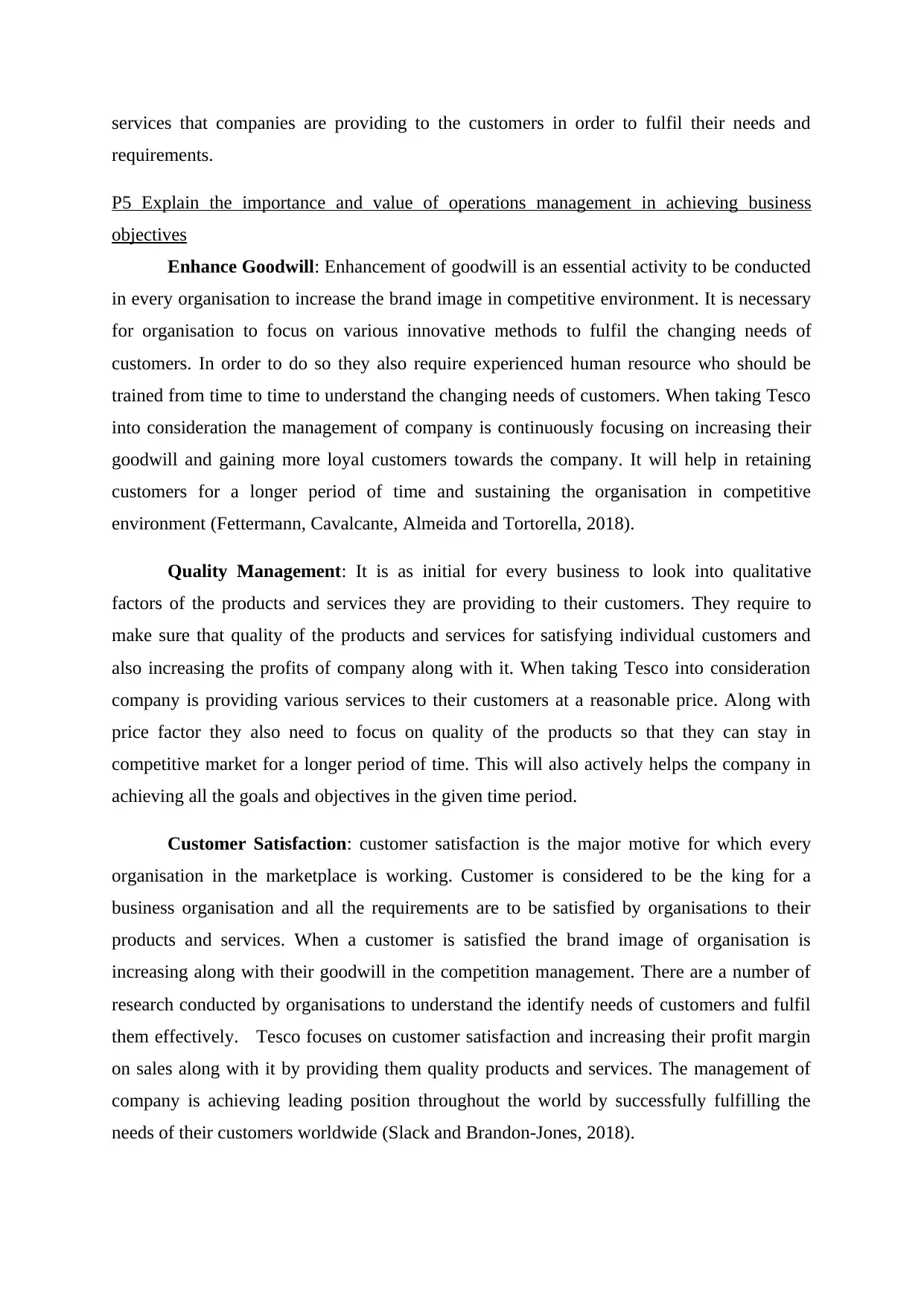
services that companies are providing to the customers in order to fulfil their needs and
requirements.
P5 Explain the importance and value of operations management in achieving business
objectives
Enhance Goodwill: Enhancement of goodwill is an essential activity to be conducted
in every organisation to increase the brand image in competitive environment. It is necessary
for organisation to focus on various innovative methods to fulfil the changing needs of
customers. In order to do so they also require experienced human resource who should be
trained from time to time to understand the changing needs of customers. When taking Tesco
into consideration the management of company is continuously focusing on increasing their
goodwill and gaining more loyal customers towards the company. It will help in retaining
customers for a longer period of time and sustaining the organisation in competitive
environment (Fettermann, Cavalcante, Almeida and Tortorella, 2018).
Quality Management: It is as initial for every business to look into qualitative
factors of the products and services they are providing to their customers. They require to
make sure that quality of the products and services for satisfying individual customers and
also increasing the profits of company along with it. When taking Tesco into consideration
company is providing various services to their customers at a reasonable price. Along with
price factor they also need to focus on quality of the products so that they can stay in
competitive market for a longer period of time. This will also actively helps the company in
achieving all the goals and objectives in the given time period.
Customer Satisfaction: customer satisfaction is the major motive for which every
organisation in the marketplace is working. Customer is considered to be the king for a
business organisation and all the requirements are to be satisfied by organisations to their
products and services. When a customer is satisfied the brand image of organisation is
increasing along with their goodwill in the competition management. There are a number of
research conducted by organisations to understand the identify needs of customers and fulfil
them effectively. Tesco focuses on customer satisfaction and increasing their profit margin
on sales along with it by providing them quality products and services. The management of
company is achieving leading position throughout the world by successfully fulfilling the
needs of their customers worldwide (Slack and Brandon-Jones, 2018).
requirements.
P5 Explain the importance and value of operations management in achieving business
objectives
Enhance Goodwill: Enhancement of goodwill is an essential activity to be conducted
in every organisation to increase the brand image in competitive environment. It is necessary
for organisation to focus on various innovative methods to fulfil the changing needs of
customers. In order to do so they also require experienced human resource who should be
trained from time to time to understand the changing needs of customers. When taking Tesco
into consideration the management of company is continuously focusing on increasing their
goodwill and gaining more loyal customers towards the company. It will help in retaining
customers for a longer period of time and sustaining the organisation in competitive
environment (Fettermann, Cavalcante, Almeida and Tortorella, 2018).
Quality Management: It is as initial for every business to look into qualitative
factors of the products and services they are providing to their customers. They require to
make sure that quality of the products and services for satisfying individual customers and
also increasing the profits of company along with it. When taking Tesco into consideration
company is providing various services to their customers at a reasonable price. Along with
price factor they also need to focus on quality of the products so that they can stay in
competitive market for a longer period of time. This will also actively helps the company in
achieving all the goals and objectives in the given time period.
Customer Satisfaction: customer satisfaction is the major motive for which every
organisation in the marketplace is working. Customer is considered to be the king for a
business organisation and all the requirements are to be satisfied by organisations to their
products and services. When a customer is satisfied the brand image of organisation is
increasing along with their goodwill in the competition management. There are a number of
research conducted by organisations to understand the identify needs of customers and fulfil
them effectively. Tesco focuses on customer satisfaction and increasing their profit margin
on sales along with it by providing them quality products and services. The management of
company is achieving leading position throughout the world by successfully fulfilling the
needs of their customers worldwide (Slack and Brandon-Jones, 2018).
⊘ This is a preview!⊘
Do you want full access?
Subscribe today to unlock all pages.

Trusted by 1+ million students worldwide
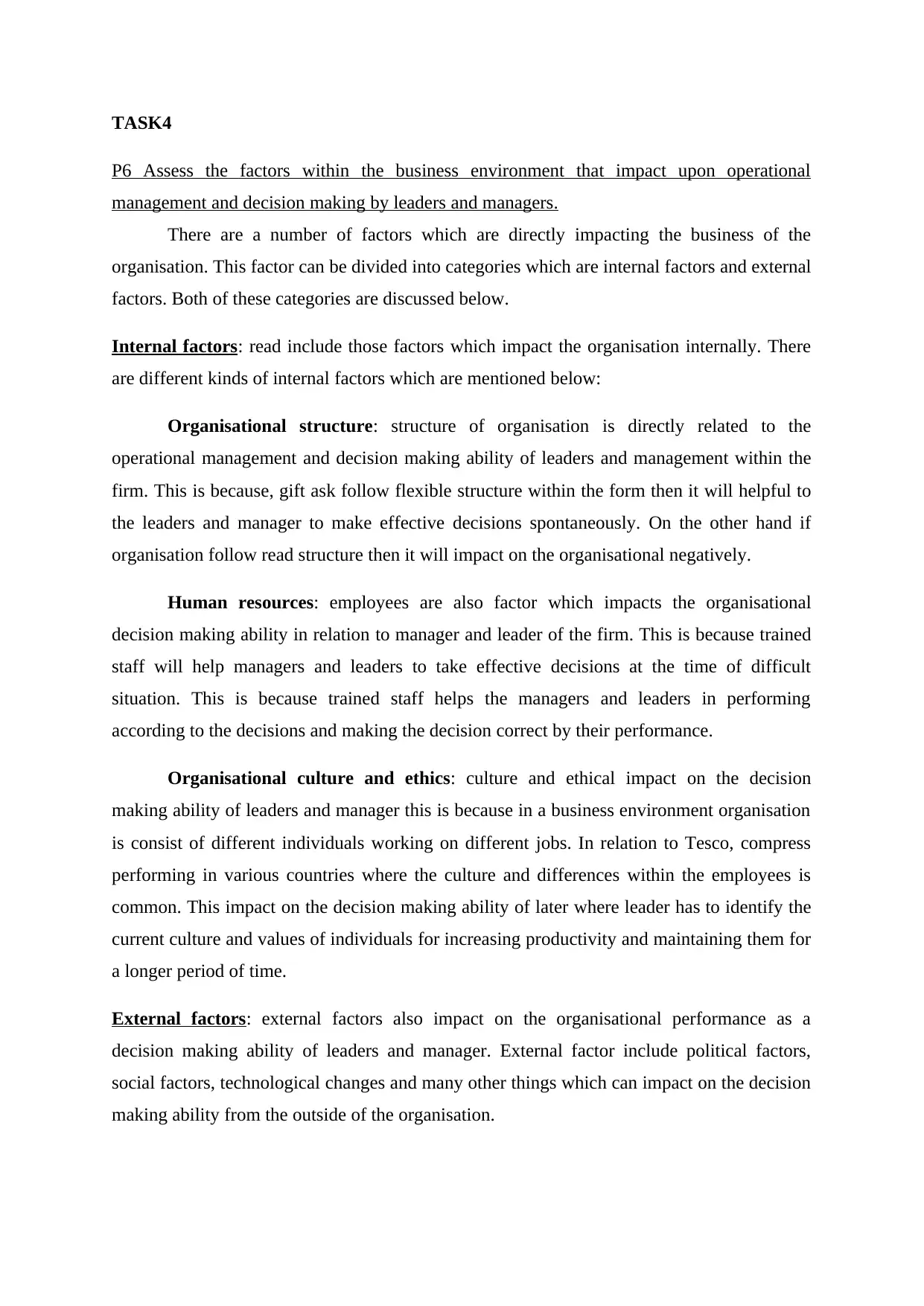
TASK4
P6 Assess the factors within the business environment that impact upon operational
management and decision making by leaders and managers.
There are a number of factors which are directly impacting the business of the
organisation. This factor can be divided into categories which are internal factors and external
factors. Both of these categories are discussed below.
Internal factors: read include those factors which impact the organisation internally. There
are different kinds of internal factors which are mentioned below:
Organisational structure: structure of organisation is directly related to the
operational management and decision making ability of leaders and management within the
firm. This is because, gift ask follow flexible structure within the form then it will helpful to
the leaders and manager to make effective decisions spontaneously. On the other hand if
organisation follow read structure then it will impact on the organisational negatively.
Human resources: employees are also factor which impacts the organisational
decision making ability in relation to manager and leader of the firm. This is because trained
staff will help managers and leaders to take effective decisions at the time of difficult
situation. This is because trained staff helps the managers and leaders in performing
according to the decisions and making the decision correct by their performance.
Organisational culture and ethics: culture and ethical impact on the decision
making ability of leaders and manager this is because in a business environment organisation
is consist of different individuals working on different jobs. In relation to Tesco, compress
performing in various countries where the culture and differences within the employees is
common. This impact on the decision making ability of later where leader has to identify the
current culture and values of individuals for increasing productivity and maintaining them for
a longer period of time.
External factors: external factors also impact on the organisational performance as a
decision making ability of leaders and manager. External factor include political factors,
social factors, technological changes and many other things which can impact on the decision
making ability from the outside of the organisation.
P6 Assess the factors within the business environment that impact upon operational
management and decision making by leaders and managers.
There are a number of factors which are directly impacting the business of the
organisation. This factor can be divided into categories which are internal factors and external
factors. Both of these categories are discussed below.
Internal factors: read include those factors which impact the organisation internally. There
are different kinds of internal factors which are mentioned below:
Organisational structure: structure of organisation is directly related to the
operational management and decision making ability of leaders and management within the
firm. This is because, gift ask follow flexible structure within the form then it will helpful to
the leaders and manager to make effective decisions spontaneously. On the other hand if
organisation follow read structure then it will impact on the organisational negatively.
Human resources: employees are also factor which impacts the organisational
decision making ability in relation to manager and leader of the firm. This is because trained
staff will help managers and leaders to take effective decisions at the time of difficult
situation. This is because trained staff helps the managers and leaders in performing
according to the decisions and making the decision correct by their performance.
Organisational culture and ethics: culture and ethical impact on the decision
making ability of leaders and manager this is because in a business environment organisation
is consist of different individuals working on different jobs. In relation to Tesco, compress
performing in various countries where the culture and differences within the employees is
common. This impact on the decision making ability of later where leader has to identify the
current culture and values of individuals for increasing productivity and maintaining them for
a longer period of time.
External factors: external factors also impact on the organisational performance as a
decision making ability of leaders and manager. External factor include political factors,
social factors, technological changes and many other things which can impact on the decision
making ability from the outside of the organisation.
Paraphrase This Document
Need a fresh take? Get an instant paraphrase of this document with our AI Paraphraser
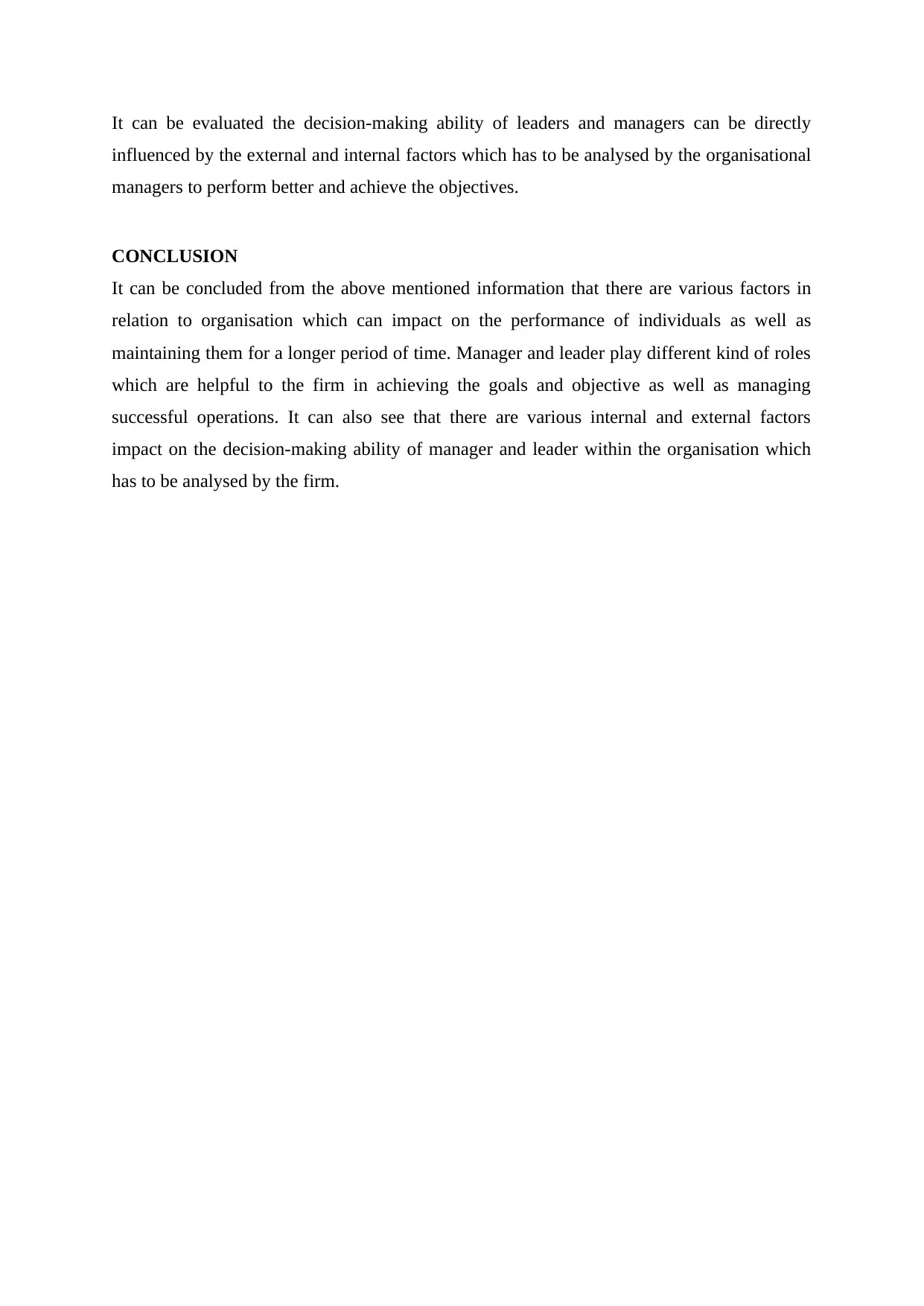
It can be evaluated the decision-making ability of leaders and managers can be directly
influenced by the external and internal factors which has to be analysed by the organisational
managers to perform better and achieve the objectives.
CONCLUSION
It can be concluded from the above mentioned information that there are various factors in
relation to organisation which can impact on the performance of individuals as well as
maintaining them for a longer period of time. Manager and leader play different kind of roles
which are helpful to the firm in achieving the goals and objective as well as managing
successful operations. It can also see that there are various internal and external factors
impact on the decision-making ability of manager and leader within the organisation which
has to be analysed by the firm.
influenced by the external and internal factors which has to be analysed by the organisational
managers to perform better and achieve the objectives.
CONCLUSION
It can be concluded from the above mentioned information that there are various factors in
relation to organisation which can impact on the performance of individuals as well as
maintaining them for a longer period of time. Manager and leader play different kind of roles
which are helpful to the firm in achieving the goals and objective as well as managing
successful operations. It can also see that there are various internal and external factors
impact on the decision-making ability of manager and leader within the organisation which
has to be analysed by the firm.
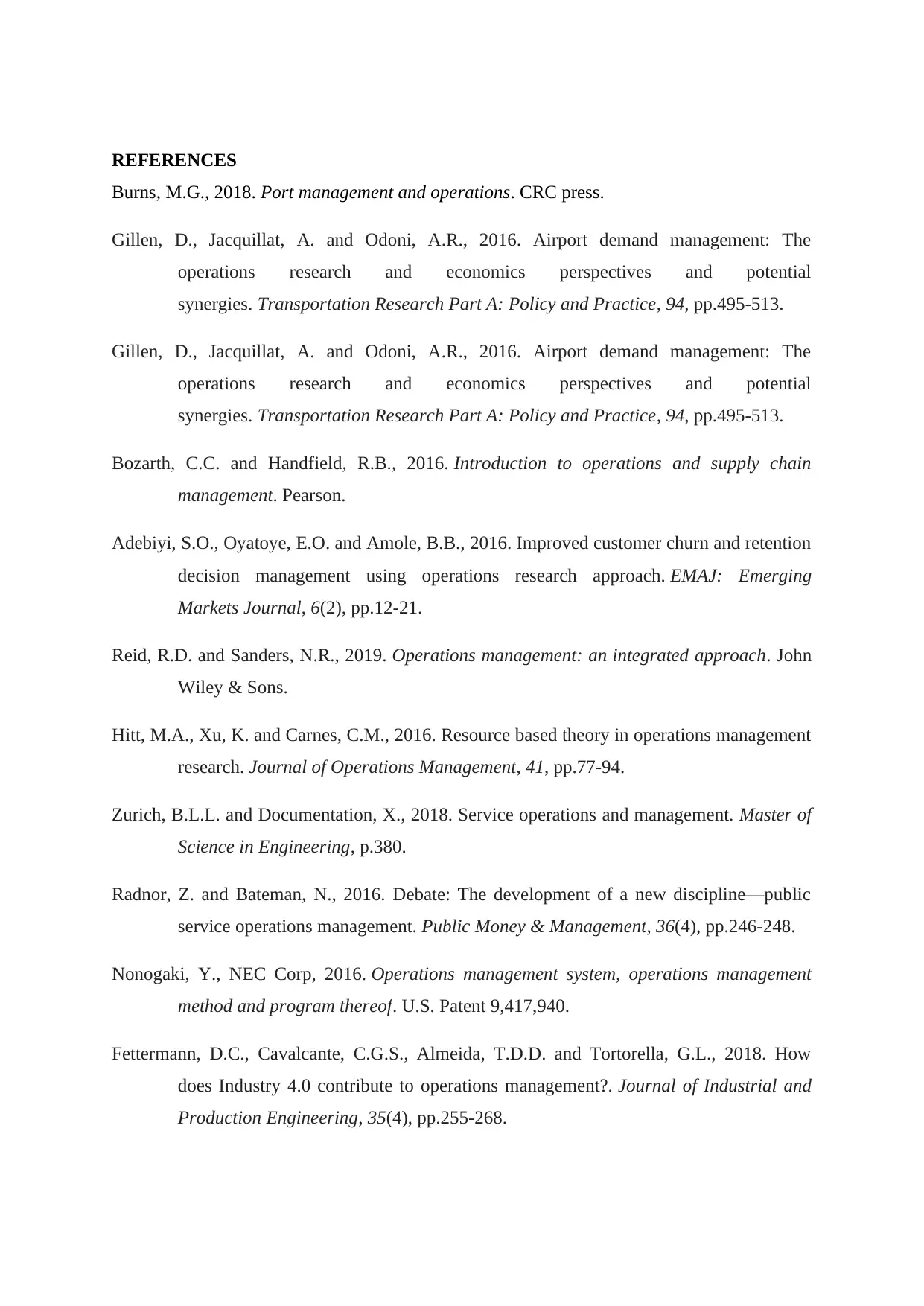
REFERENCES
Burns, M.G., 2018. Port management and operations. CRC press.
Gillen, D., Jacquillat, A. and Odoni, A.R., 2016. Airport demand management: The
operations research and economics perspectives and potential
synergies. Transportation Research Part A: Policy and Practice, 94, pp.495-513.
Gillen, D., Jacquillat, A. and Odoni, A.R., 2016. Airport demand management: The
operations research and economics perspectives and potential
synergies. Transportation Research Part A: Policy and Practice, 94, pp.495-513.
Bozarth, C.C. and Handfield, R.B., 2016. Introduction to operations and supply chain
management. Pearson.
Adebiyi, S.O., Oyatoye, E.O. and Amole, B.B., 2016. Improved customer churn and retention
decision management using operations research approach. EMAJ: Emerging
Markets Journal, 6(2), pp.12-21.
Reid, R.D. and Sanders, N.R., 2019. Operations management: an integrated approach. John
Wiley & Sons.
Hitt, M.A., Xu, K. and Carnes, C.M., 2016. Resource based theory in operations management
research. Journal of Operations Management, 41, pp.77-94.
Zurich, B.L.L. and Documentation, X., 2018. Service operations and management. Master of
Science in Engineering, p.380.
Radnor, Z. and Bateman, N., 2016. Debate: The development of a new discipline—public
service operations management. Public Money & Management, 36(4), pp.246-248.
Nonogaki, Y., NEC Corp, 2016. Operations management system, operations management
method and program thereof. U.S. Patent 9,417,940.
Fettermann, D.C., Cavalcante, C.G.S., Almeida, T.D.D. and Tortorella, G.L., 2018. How
does Industry 4.0 contribute to operations management?. Journal of Industrial and
Production Engineering, 35(4), pp.255-268.
Burns, M.G., 2018. Port management and operations. CRC press.
Gillen, D., Jacquillat, A. and Odoni, A.R., 2016. Airport demand management: The
operations research and economics perspectives and potential
synergies. Transportation Research Part A: Policy and Practice, 94, pp.495-513.
Gillen, D., Jacquillat, A. and Odoni, A.R., 2016. Airport demand management: The
operations research and economics perspectives and potential
synergies. Transportation Research Part A: Policy and Practice, 94, pp.495-513.
Bozarth, C.C. and Handfield, R.B., 2016. Introduction to operations and supply chain
management. Pearson.
Adebiyi, S.O., Oyatoye, E.O. and Amole, B.B., 2016. Improved customer churn and retention
decision management using operations research approach. EMAJ: Emerging
Markets Journal, 6(2), pp.12-21.
Reid, R.D. and Sanders, N.R., 2019. Operations management: an integrated approach. John
Wiley & Sons.
Hitt, M.A., Xu, K. and Carnes, C.M., 2016. Resource based theory in operations management
research. Journal of Operations Management, 41, pp.77-94.
Zurich, B.L.L. and Documentation, X., 2018. Service operations and management. Master of
Science in Engineering, p.380.
Radnor, Z. and Bateman, N., 2016. Debate: The development of a new discipline—public
service operations management. Public Money & Management, 36(4), pp.246-248.
Nonogaki, Y., NEC Corp, 2016. Operations management system, operations management
method and program thereof. U.S. Patent 9,417,940.
Fettermann, D.C., Cavalcante, C.G.S., Almeida, T.D.D. and Tortorella, G.L., 2018. How
does Industry 4.0 contribute to operations management?. Journal of Industrial and
Production Engineering, 35(4), pp.255-268.
⊘ This is a preview!⊘
Do you want full access?
Subscribe today to unlock all pages.

Trusted by 1+ million students worldwide
1 out of 13
Related Documents
Your All-in-One AI-Powered Toolkit for Academic Success.
+13062052269
info@desklib.com
Available 24*7 on WhatsApp / Email
![[object Object]](/_next/static/media/star-bottom.7253800d.svg)
Unlock your academic potential
Copyright © 2020–2025 A2Z Services. All Rights Reserved. Developed and managed by ZUCOL.



